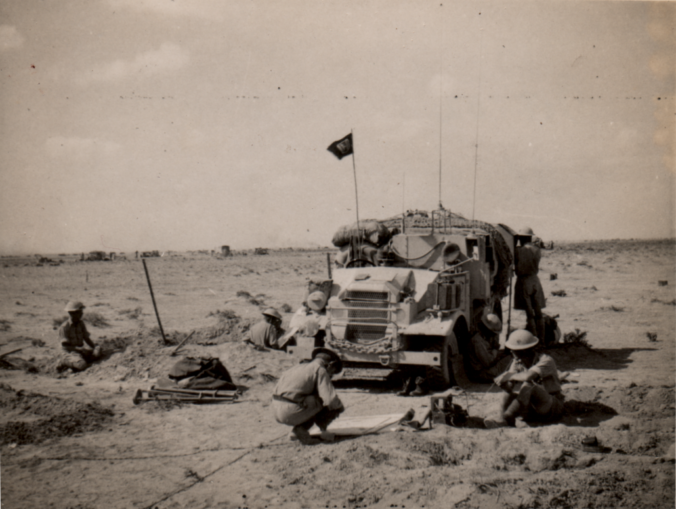
Previously unpublished photo courtesy of DJM’s uncle David, © 2023
With the Axis on the run in Tunisia it was only a matter of time until they had to surrender. Their supply routes to Tunisia were under constant attack and the Axis could do little about it even though they fought back and cost the Allied navies dearly.
On the 3rd The German submarine U-83 under command of Kapitänleutnant Ulrich Wörisshoffer was sunk south-east of Cartagena, Spain in the Mediterranean Sea by three depth charges dropped from a British Hudson aircraft. All 50 on board the submarine were lost. While patrolling off Sousse, Tunisia the British submarine HMS Unseen destroyed the wreck of the 2,785-ton German merchant ship Macedonia that had been torpedoed and damaged by HMS P 35 on 13 Dec 1942. Macedonia had then been beached by her crew to prevent her sinking. An air attack on 15 Dec 1942 had damaged her even further. Her cargo was being salvaged when Unseen attacked. There were no casualties.
On the 6th Axis forces launched a failed pre-emptive strike, Operation Capri, in southeastern Tunisia near Medenine. The operation was canceled by the evening as Rommel concluded that his forces did not have the initiative of battle. The German 71st Werfer Regiment went into action in support of Field Marshal Rommel’s disastrous tank attack on the Eighth Army at Medenine in Tunisia. Personally brought forward by Oberstleutnant (Lieutenant Colonel) Count Claus von Stauffenberg, later organizer of the 1944 bomb plot against Hitler, the regiment’s three batteries were rapidly knocked out by Allied fighter bombers, the dust thrown up during launching the Nebelwerfer rockets revealed their camouflaged positions.
On the 7th the 1,947-ton Italian steamship Balzac (formerly the British Tadorna) and the 1,984-ton French steamship Henri Estier were bombed and sunk by US aircraft 20 miles north-north-east of Zembra Island off the coast of Tunisia. The rearguard of the retreating Operation Capri forces engaged pursuing Allied forces in small-scale combat south of the Mareth Line in Tunisia.
On the 8th Allied forces pursuing the retreating Operation Capri forces gave up the chase due to poor weather in southeastern Tunisia.
On the 9th Erwin Rommel departed North Africa on account of health reasons or was it squeaky bum time.
On the 10th Axis forces participating in the failed Operation Capri attack in southeastern Tunisia fell back to the Mareth Line.
On the 11th Erwin Rommel received Diamonds to his Knight’s Cross medal.
On the 12th At 2210 hours the 3,100-ton Italian merchant ship Esterel was torpedoed by British submarine HMS Thunderbolt two miles north of San Vito Lo Capo, Sicily. Following the attack the torpedo boat Libra was ordered to find the attacker. The British destroyer HMS Lighting (G55) departed Bône, Algeria at 1745 hours to join Force Q for a sweep in the Mediterranean Sea. At 1851 hours Lightning was attacked by twelve German torpedo bombers; her anti-aircraft guns shot down one. At 2215 hours, German motor torpedo boat S-158 fired a torpedo at her. Lightning turned hard to port to avoid the torpedo, but she was nevertheless struck, severely damaging the bow. Commander Hugh Greaves Walters gave the order to stop so as to prevent further damage. As she slowed she was struck by a second torpedo beneath the funnel, which broke her in two. Her bow and stern sections remained vertical in the water for a while before sinking. 46 men were lost and 181 survived. One survivor was picked up by S-158 and the remaining 180 survivors (including Walters) were picked up some hours later by sister ship Loyal.
On the 13th 180 survivors of HMS Lighting (G55), sunk by German motor torpedo boat S-158 on the previous day, were landed at Bône, Algeria by destroyer HMS Loyal.
On the 15th 36 P-40L fighters of USAAF 33rd Fighter Group, while escorting a flight of B-25 bombers en route to Mezzouna, Tunisia, shot down 3 of a group of German fighters attempting to intercept them.
On the 17th US troops captured Gafsa, Tunisia.
On the 18th Italians began to raise the wreck of Algérie in sections at Toulon, France. US 1st Ranger Battalion captured El Guettar, Tunisia.
On the 19th the British launched Operation Pugilist in Tunisia against the Axis Mareth Line, breaking through the line near Zarat. The Mareth Line was a series of blockhouses built by the French but they were not suited to the demands of 1940s weaponry.
On the 20th the Eighth Army broke through German Mareth Line in Tunisia. The 1,474-ton Greek merchant steamer Varvara carrying munitions from Alexandria, Egypt received fatal damage from German aircraft 500 yards southwest of the Tripoli harbour entrance, Libya.
On the 21st New Zealand troops under Lieutenant General Bernard Freyberg bypassed the Mareth Line defences in Tunisia by moving his forces through Wilder’s Gap to the west. They engaged surprised German defences at the Tebaga Gap. Lieutenant Colonel Derek Seagram won a posthumous Victoria Cross for leading an attack on the Mareth Line in Tunisia. He inspired his men by being first across the scaling ladders over the German anti-tank ditches but was mortally wounded in the fighting.
On the 22nd American troops captured Maknassy, Tunisia. German 15th Panzer Division neared Zarat, Tunisia, recapturing territory lost at the opening of the British Operation Pugilist.
On the 23rd German 10th Panzer Division counterattacked the advancing American troops in the El Guettar region in Tunisia; heavy American anti-tank fire repulsed the German attack. German Luftwaffe aircraft sank HMS Windsor Castle off Algeria. Bernard Montgomery released British 1st Armoured Division from reserve to reinforce the New Zealand troops’ offensive near Zarat, Tunisia. The Indian 4th Division attacked the western end of the Mareth Line in coordination.
On the 25th the Indian 4th Division overran the Mareth Line in Tunisia.
On the 26th In the afternoon, British launched Operation Supercharge II to attack Axis defences in Tunisia near the Tebaga Gap. At 2300 hours, as the moon rose to provide some light, British tanks pushed through the gap and approached on El Hamma to the north. Tanks of the German 15th Panzer Division were released from reserve to counter the offensive. Axis troops began retreating from the Mareth Line in Tunisia toward Wadi Akarit. The 7,047-ton British cargo transport steamer Empire Standard was bombed and sunk by German aircraft at Algiers. At 1842 hours, German submarine U-77 fired three torpedoes at the convoy MKS-10 northwest of Oran, Algeria and saw columns of smoke rising above the target after the first torpedo hit. Two further detonations were heard However, only the City of Perth was hit. The vessel was taken in tow by the British armed trawler HMS Man O’War (FY 104) and beached south of Cape Figalo, Algeria and became a total loss. Two gunners were lost. The master, 78 crew members and 11 gunners were rescued by the armed trawler.
On the 27th German tanks stopped the British offensive at El Hamma, Tunisia, but New Zealand troops had successfully secured territory south of the town.
On the 28th most Axis troops were evacuated from the Mareth Line in Tunisia to form a new line to the north. US 12th Air Force bombed the oil refinery at Livorno, Italy.
On the 29th New Zealand troops captured Gabès, Tunisia while Axis troops were evacuated out of El Hamma.
On the 30th General Montgomery’s troops breached the Mareth Line in North Africa. US 1st and 9th Infantry Divisions attacked Italian positions at Hill 369 near El Guettar, Tunisia with little success. German submarine U-596 attacked the convoy ET-16 when west of Algiers and reported five hits on two ships. The Norwegian motor tanker and the British Liberty ship Fort a la Corne were sunk during this attack. The Hallananger was on route from Algiers for Gibraltar and New York in ballast and carrying 1000 tons of fuel oil. The 40 crew members and four gunners abandoned ship in the lifeboats and reached land the next day and were subsequently sent to Algiers. The Fort a la Corne was in ballast and the crew were picked up by escort vessels.
On the 31st British troops occupied Cap Serrat on the Tunisian coast. Operation Supercharge II was concluded successfully in Tunisia, forcing the Axis defences to move north to Wadi Akarit. USAAF bombers attacked the Italian airfield at Cagliari, Sardinia. US 1st and 9th Infantry Divisions again attacked Italian positions at Hill 369 near El Guettar, Tunisia with little success.
In other news – on the 1st Heinz Guderian was appointed Inspector-General of Armoured Troops, on the 2nd the rabid anti-semite Joseph Goebbels’ diary entry on this date noted that “we are now definitely pushing the Jews out of Berlin” and explained that many Jews were still in hiding in the city and they needed to be found and deported, on the 3rd Hitler survived an assassination attempt, on the 5th the first Gloster Meteor aircraft made its maiden flight the Meteor would go on to become the only turbojet powered Allied aircraft operational during the war, on the 8th the American ban on sliced bread, originally intended on saving wrapping paper but found to be ineffective, was lifted, on the 11th Joseph Goebbels ordered the SS and Security Police to round up the 4,000 Berlin Jews who had escaped Operation Factory at the end of February 1943, on the 13th a plot to assassinate Hitler during a flight from Smolensk, Russia to Rastenburg, Germany when Adolf Hitler visited Günther von Kluge’s field headquarters failed, anti-Hitler conspirators spoke to Kluge beforehand, but they could not convince Kluge to take action to arrest Hitler, without Kluge’s help, the conspirators acted on their own, sneaking fused bombs disguised as brandy bottles aboard Hitler’s aircraft, which took off for Berlin, Germany after dinner, the bombs failed to explode, and the conspirators had to take the risk, successfully, to retrieve the bottles before they were discovered, on the 15th the British Royal Navy launched the first of the X-class midget submarines, on the 17th Bulgaria stated its opposition to the deportation of Bulgarian Jews, on the 20th Churchill’s post war plans, broadcast over radio, were criticised as very socialist, on the 21st Adolf Hitler, Hermann Göring, Wilhelm Keitel, Karl Dönitz, Heinrich Himmler, Fedor von Bock, Erhard Milch, and others visited the Zeughaus in Berlin, Germany to inspect an exhibition featuring captured Soviet weapons, it was Hitler’s first public event in four months but at the Zeughaus, Colonel Rudolf von Gersdorff wore an overcoat packed with explosives with the intention of killing Hitler, however Hitler’s schedule changed unexpectedly and Hitler’s early departure from the exhibition caused the assassination attempt to be called off, after departing from the exhibition, the group of German leaders attended a memorial ceremony for the Heroes’ Memorial Day, on the 22nd two captured German generals spoke of plans for long range missiles in a room in Kensington Park Gardens, London, not realising that the room had been bugged, on the 24th British General Orde Wingate was ordered by his superiors to withdraw his Chindits from Burma, on the 26th British General Wingate ordered his Chindits in Burma to withdraw.
March finished with the Axis forces on the run, Rommel had by then skedadalled. The Americans get a fair bit of stick for their showing during this part of the campaign but we have to remember this was the first action most of them had seen.
March 1943 saw 40,000 tons of supplies delivered to Malta, the siege was finally broken. More than 1,300 civilians had been killed in 1,660 bombing attacks. Malta deserved the George Medal it had been awarded.
© well_chuffed 2023



